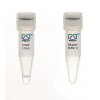Highly active recombinant alkaline phosphatase from the marine bacterium Cobetia marina

Highly active recombinant alkaline phosphatase from the marine bacterium Cobetia marina
Description. Highly active recombinant alkaline phosphatase from the marine bacterium Cobetia marina (CmAP) is a monomer with a molecular weight of 55 kDa. It is a very effective tool for dephosphorylatiоn of linearized vector prior to ligation. It is also able to dephosphorylate various substrates with a phosphate group available for this enzyme. Monomeric CmAP unlike other commercial alkaline phosphatases is a tool for plasmid-frames. Due to very high specific activity it acts as a powerful tool for immunologic research; for the production of recombinant diagnostic antibodies to cell receptors (proteins benchmark); for dephosphorylating DNA and different proteins. In addition, it can be rapidly inactivated in the reaction by heating for 10 min at 65°C.
Source: The enzyme was fully purified from the recombinant E. coli strain.
Storage conditions: 50 mM Tris-HCl (pH 8.5) buffer solution with 100 mM NaCl, 0,01% NaN3, store at - 20 °C. The enzyme is stable for at least 1 year without losing activity.
Specific activity - 3800 units / mg (Tris-HCl buffer, pH ~ 10)
- 13 000 units / mg (Diethanolamine buffer (DEA), pH 10.3)
Unit Definition: One unit of activity is the amount of enzyme required to form 1 mM p-nitrophenol (p-NP) from 4-nitrophenylphosphate (p-NPP) per minute at 37 °C.
Reaction conditions: 100 mM tris-HCl, 0.2M KCl (pH ~ 10) or 1 M diethanolamine (pH 10.3) at 37 °C. The preparation also exhibits 3-25% activity at pH 6-11 in the acetate, carbonate, and glycine buffers at temperatures from 5 to 50 °C.
Inactivation: Alkaline phosphatase completely denatures after heating for 10 min at 65°C.
Concentration: 0.25 mg/ml (according to Bradford method)
1 unit/µl (Tris-HCl buffer, pH ~ 10)
3 units/µl (Diethanolamine buffer (DEA), pH 10.3)
Dilution buffers: A: 50 mM tris-HCl (pH 8.5)
B: 100 mM tris-HCl (pH ~ 10), 0.2 M KCl
C: 1 M diethanolamine (pH 10.3)
